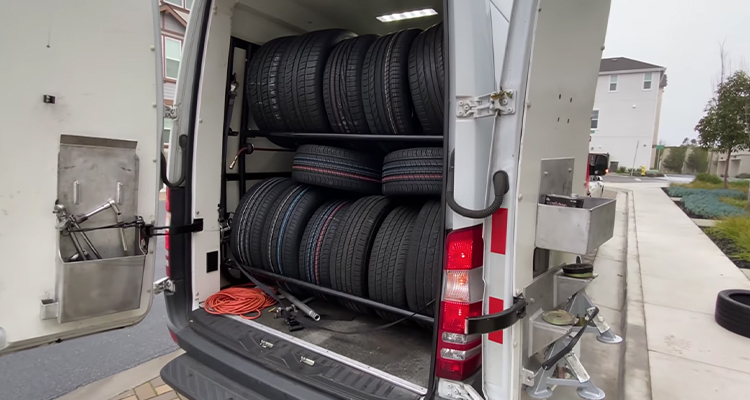Tire Solution: Proven Approaches for Ideal Tire Upkeep and Treatment
Keeping optimal tire problem is extremely important for both security and performance of any lorry. From making certain proper tire pressure to normal rotation and placement, there are tested techniques that can dramatically extend the life expectancy of your tires and boost total driving experience. As we explore the intricacies of tire treatment and maintenance, we will certainly reveal vital guidelines that every lorry owner must stick to for the very best feasible outcomes. Let's dive right into the world of tire service and find the tricks to keeping your tires in superior shape for the long run.
Importance of Tire Pressure
Appropriate tire pressure is an essential consider making certain ideal car efficiency and security when traveling. Preserving the suggested tire pressure levels supplied by the maker uses many benefits. Firstly, appropriate tire stress promotes much better fuel performance, as under-inflated tires can bring about enhanced rolling resistance, triggering the engine to function harder and eat more gas. Correct tire pressure ensures even tread wear, improving tire long life and saving money in the lengthy run by postponing the demand for premature substitutes. In addition, properly inflated tires add to improved handling and stopping capacities, important for risk-free driving in different road problems. Over-inflated tires, on the other hand, can result in decreased traction and a harsher trip. Alternatively, under-inflated tires are susceptible to overheating, which can cause blowouts and accidents. Routinely adjusting and examining tire stress, specifically in the past long trips, is an easy yet effective way to enhance car performance, extend tire lifespan, and focus on safety on the road.
Tire Rotation Guidelines
When thinking about tire rotation standards, it is important to recognize the importance of this maintenance job in optimizing tire lifespan and preserving optimal vehicle performance. Tire turning includes transforming the position of each tire on a vehicle to make sure even tread wear. Front tires often tend to use a lot more promptly than back tires due to guiding pressures, making regular rotation important for balanced wear patterns. The suggested rotation pattern differs relying on whether an automobile is front-wheel, rear-wheel, all-wheel, or 4x4. Typically, tires must be turned every 5,000 to 7,500 miles, or as encouraged in the automobile manual. Neglecting tire rotation can cause unequal wear, impacting handling, grip, and potentially compromising lorry security. By adhering to correct rotation standards, vehicle drivers can extend the life of their tires, visit site enhance gas effectiveness, and boost overall driving experience. Routine turning is a simple yet efficient upkeep practice that contributes substantially to tire long life and car efficiency.

Benefits of Wheel Placement
Ensuring appropriate wheel positioning after tire turning is important for keeping balanced wear patterns and optimizing car performance. Additionally, appropriate wheel placement helps to prolong the lifespan of your tires. Misaligned wheels can trigger uneven tire wear, leading to early tire substitute and boosted maintenance prices.

Tire Footstep Deepness Inspect
Doing a regular examination of tire tread depth is important for maintaining safe driving problems and extending the life expectancy of your tires. Irregular step wear can suggest issues with tire pressure, suspension, or positioning, highlighting the relevance of regular step depth checks. By integrating tire walk deepness checks into your regular maintenance timetable, you can drive with confidence recognizing that your tires are in leading problem.
Seasonal Tire Assessment
Seasonal tire inspection is an essential aspect of tire maintenance that makes sure tires are all set to face the difficulties posed by different weather condition problems. In prep work for wintertime, it is essential to examine the tire stress routinely as cold find out here now temperatures can cause tire pressure to go down. By carrying out regular seasonal tire evaluations, vehicle drivers can lengthen tire life expectancy, improve fuel efficiency, and most significantly, make certain a protected driving experience in differing weather problems.
Verdict
To conclude, keeping appropriate tire stress, rotating tires on a regular basis, lining up wheels properly, checking step deepness, and carrying out seasonal evaluations are vital practices for ideal tire treatment. By adhering to these confirmed techniques, chauffeurs can guarantee their tires last much longer, execute much better, and add to total lorry security. It is necessary to prioritize tire maintenance to prevent crashes, improve fuel performance, and prolong the life-span of tires.
Appropriate tire pressure promotes better fuel performance, as under-inflated tires can lead to enhanced rolling resistance, causing the engine to function more difficult and take in more fuel.When taking into consideration tire rotation standards, it is necessary to recognize the importance of this upkeep task in optimizing tire lifespan and maintaining optimal vehicle performance. Seasonal tire assessment is an essential facet of tire maintenance that guarantees tires are all set to encounter the obstacles positioned by various weather problems. By performing routine seasonal tire inspections, motorists can extend tire life expectancy, boost gas effectiveness, and most notably, web make certain a protected driving experience in differing weather problems.
In conclusion, preserving proper tire stress, rotating tires routinely, lining up wheels correctly, keeping an eye on walk depth, and conducting seasonal evaluations are necessary practices for optimum tire treatment.
 Joseph Mazzello Then & Now!
Joseph Mazzello Then & Now! Danny Pintauro Then & Now!
Danny Pintauro Then & Now! Loni Anderson Then & Now!
Loni Anderson Then & Now! Talia Balsam Then & Now!
Talia Balsam Then & Now! Samantha Fox Then & Now!
Samantha Fox Then & Now!